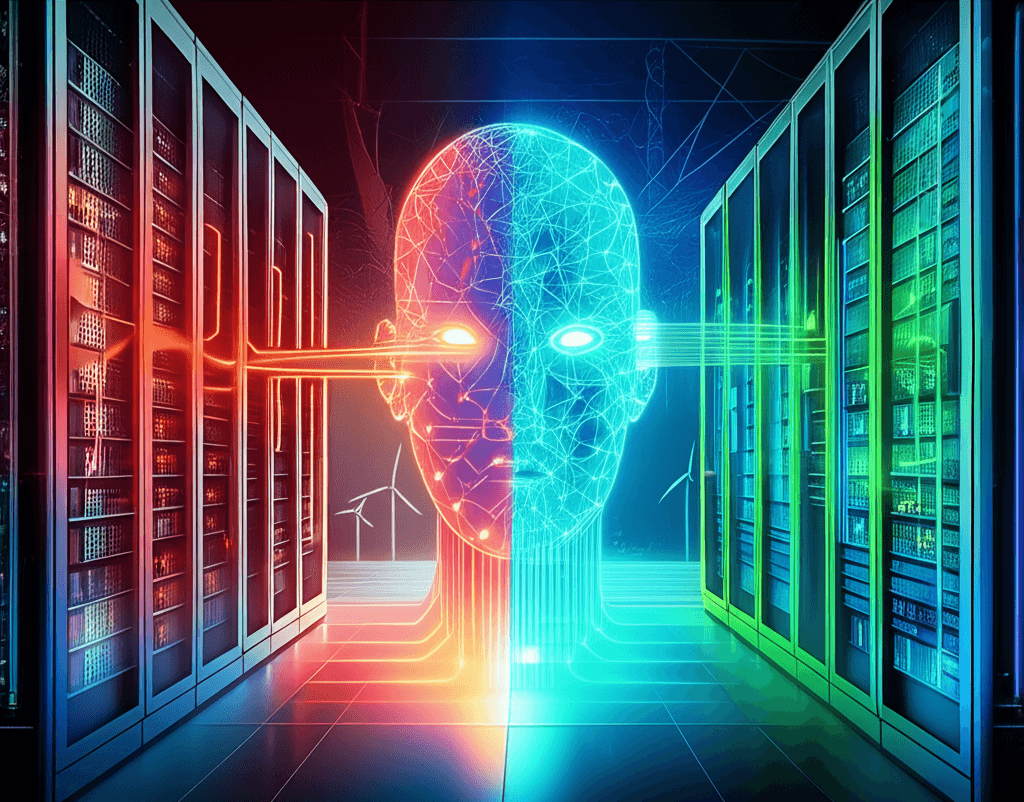AI Creates Energy Crisis, Then Intelligently Solves It for Data Centers
AI is both driving an unprecedented data center energy crisis and offering the sophisticated solutions to manage it sustainably.
July 3, 2025

Artificial intelligence is creating a profound paradox at the heart of the digital economy. It is simultaneously the source of a looming energy crisis within data centers and the most promising solution to manage it. The insatiable computational thirst of AI models is driving unprecedented growth in data center power consumption, putting immense strain on electrical grids and challenging sustainability goals. Yet, it is AI itself, through sophisticated algorithms and intelligent automation, that offers the tools to optimize these power-hungry facilities, enhance efficiency, and mitigate the very problem it creates. This dual role places AI at the epicenter of the future of digital infrastructure, forcing a rapid evolution in how data centers are designed, powered, and operated.
The scale of AI-driven energy demand is staggering and represents a fundamental shift in data center workloads. While traditional computing tasks have relatively stable power needs, training and running complex AI models, particularly large language models and generative AI, are exceptionally energy-intensive.[1] A single Google search using a traditional algorithm consumes about 0.3 watt-hours, whereas a query to a generative AI like ChatGPT can use nearly ten times that amount.[1] This surge in demand is fueled by the specialized hardware required for AI, such as graphics processing units (GPUs) and custom AI accelerators, which consume significantly more power and generate far more heat than standard CPUs.[2] As a result, global data center electricity consumption is projected to more than double between 2023 and 2028.[3] Some projections indicate that by 2030, data centers could account for a significant percentage of total electricity use in major economies, with AI workloads being the primary driver of this growth.[4][1] This exponential increase is not just about total consumption but also about power density; AI workloads can demand 50kW to over 100kW per rack, a massive jump from the 7-10kW required for typical enterprise applications.[5][6] This intensification strains not only the power supply but also puts pressure on the physical infrastructure, necessitating new approaches to data center construction and location.[7][8]
In response to this escalating power crisis, the industry is increasingly turning to AI to manage its own footprint. AI-powered optimization is emerging as a critical tool for enhancing data center efficiency and sustainability.[9] By analyzing vast datasets from sensors monitoring temperature, energy consumption, and network traffic, AI systems can make real-time, automated adjustments to maintain optimal operating conditions.[10] One of the most significant applications is in cooling, which can account for up to 40% of a data center's total energy use.[11] AI algorithms can predict thermal patterns and dynamically manage cooling systems, a strategy that has enabled companies like Google to reduce their cooling costs by as much as 40%.[12] Beyond cooling, AI is used for intelligent workload management, distributing computing tasks across servers in the most energy-efficient manner to prevent overloads and minimize waste.[12][10] Predictive maintenance is another key area where AI helps; by analyzing hardware performance data, it can anticipate equipment failures before they happen, reducing downtime and extending the lifespan of critical components.[13] These intelligent systems transform data centers from static facilities into dynamic, self-optimizing ecosystems.[14][15]
The unique demands of AI are fundamentally reshaping the physical design and infrastructure of data centers. Facilities built for previous generations of IT are often ill-equipped to handle the power and heat densities of modern AI hardware.[6] This is driving a new era of data center construction specifically architected for AI, featuring more robust power delivery and advanced cooling solutions.[8] Liquid cooling, including methods like immersion cooling where servers are submerged in a dielectric fluid, is becoming more mainstream as traditional air cooling proves insufficient for the heat generated by high-density GPU clusters.[16][2] The electrical architecture within these new data centers is also evolving, with a shift toward higher-voltage power distribution to improve efficiency and reduce energy loss.[7] Furthermore, the distinction between AI training and inference workloads influences facility design; training requires massive internal network bandwidth, while inference demands low-latency connections to end-users, potentially driving some processing to edge data centers closer to the consumer.[5] This has led to a surge in investment in new, specialized data centers, with some companies exploring radical energy solutions, including partnerships to utilize nuclear power, to meet the immense and growing demand.[17][18]
Ultimately, the intertwined relationship between AI and data centers underscores a critical inflection point for the technology industry. The explosive growth in AI capabilities cannot be sustained without addressing the environmental and infrastructural consequences of its energy consumption. This has elevated sustainability from a corporate social responsibility issue to a core business imperative.[19] The challenge is not merely to build more data centers but to build smarter, more efficient ones powered by clean energy.[20] This involves a multi-faceted approach, from designing more energy-efficient AI algorithms and hardware to integrating renewable energy sources like solar and wind directly into data center power strategies.[19][21] AI is an indispensable ally in this effort, providing the intelligence needed to optimize every facet of data center operations.[22] The future of both AI and the digital infrastructure that underpins our world will depend on successfully navigating this complex balance, ensuring that the technology empowering the future does not undermine it through an unsustainable demand for power.
Sources
[3]
[7]
[8]
[10]
[11]
[15]
[16]
[17]
[19]
[20]
[21]
[22]